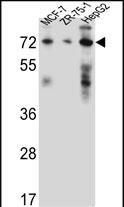HSD17B4 Antibody (Center)
Affinity Purified Rabbit Polyclonal Antibody (Pab)
- 产品详情
- 实验流程
- 背景知识
Application
| WB, IHC-P, E |
|---|---|
| Primary Accession | P51659 |
| Other Accession | NP_000405.1 |
| Reactivity | Human |
| Host | Rabbit |
| Clonality | Polyclonal |
| Isotype | Rabbit IgG |
| Calculated MW | 79686 Da |
| Antigen Region | 341-370 aa |
| Gene ID | 3295 |
|---|---|
| Other Names | Peroxisomal multifunctional enzyme type 2, MFE-2, 17-beta-hydroxysteroid dehydrogenase 4, 17-beta-HSD 4, D-bifunctional protein, DBP, Multifunctional protein 2, MPF-2, (3R)-hydroxyacyl-CoA dehydrogenase, 111n12, Enoyl-CoA hydratase 2, 3-alpha, 7-alpha, 12-alpha-trihydroxy-5-beta-cholest-24-enoyl-CoA hydratase, HSD17B4, EDH17B4 |
| Target/Specificity | This HSD17B4 antibody is generated from rabbits immunized with a KLH conjugated synthetic peptide between 341-370 amino acids from the Central region of human HSD17B4. |
| Dilution | WB~~1:1000 IHC-P~~1:100~500 E~~Use at an assay dependent concentration. |
| Format | Purified polyclonal antibody supplied in PBS with 0.09% (W/V) sodium azide. This antibody is purified through a protein A column, followed by peptide affinity purification. |
| Storage | Maintain refrigerated at 2-8°C for up to 2 weeks. For long term storage store at -20°C in small aliquots to prevent freeze-thaw cycles. |
| Precautions | HSD17B4 Antibody (Center) is for research use only and not for use in diagnostic or therapeutic procedures. |
| Name | HSD17B4 (HGNC:5213) |
|---|---|
| Synonyms | EDH17B4, SDR8C1 |
| Function | Bifunctional enzyme acting on the peroxisomal fatty acid beta-oxidation pathway. Catalyzes two of the four reactions in fatty acid degradation: hydration of 2-enoyl-CoA (trans-2-enoyl-CoA) to produce (3R)-3-hydroxyacyl-CoA, and dehydrogenation of (3R)-3- hydroxyacyl-CoA to produce 3-ketoacyl-CoA (3-oxoacyl-CoA), which is further metabolized by SCPx. Can use straight-chain and branched-chain fatty acids, as well as bile acid intermediates as substrates. |
| Cellular Location | Peroxisome. |
| Tissue Location | Present in many tissues with highest concentrations in liver, heart, prostate and testis |
For Research Use Only. Not For Use In Diagnostic Procedures.
Provided below are standard protocols that you may find useful for product applications.
BACKGROUND
The protein encoded by this gene is a bifunctional enzyme that is involved in the peroxisomal beta-oxidation pathway for fatty acids. It also acts as a catalyst for the formation of 3-ketoacyl-CoA intermediates from both straight-chain and 2-methyl-branched-chain fatty acids. Defects in this gene that affect the peroxisomal fatty acid beta-oxidation activity are a cause of D-bifunctional protein deficiency (DBPD). An apparent pseudogene of this gene is present on chromosome 8. [provided by RefSeq].
REFERENCES
Canzian, F., et al. Hum. Mol. Genet. 19(19):3873-3884(2010)
Bailey, S.D., et al. Diabetes Care 33(10):2250-2253(2010)
Kashiwayama, Y., et al. J. Biol. Chem. 285(34):26315-26325(2010)
Pierce, S.B., et al. Am. J. Hum. Genet. 87(2):282-288(2010)
Liu, C.Y., et al. Carcinogenesis 31(7):1259-1263(2010)
终于等到您。ABCEPTA(百远生物)抗体产品。
点击下方“我要评价 ”按钮提交您的反馈信息,您的反馈和评价是我们最宝贵的财富之一,
我们将在1-3个工作日内处理您的反馈信息。
如有疑问,联系:0512-88856768 tech-china@abcepta.com.























 癌症的基本特征包括细胞增殖、血管生成、迁移、凋亡逃避机制和细胞永生等。找到癌症发生过程中这些通路的关键标记物和对应的抗体用于检测至关重要。
癌症的基本特征包括细胞增殖、血管生成、迁移、凋亡逃避机制和细胞永生等。找到癌症发生过程中这些通路的关键标记物和对应的抗体用于检测至关重要。 为您推荐一个泛素化位点预测神器——泛素化分析工具,可以为您的蛋白的泛素化位点作出预测和评分。
为您推荐一个泛素化位点预测神器——泛素化分析工具,可以为您的蛋白的泛素化位点作出预测和评分。 细胞自噬受体图形绘图工具为你的蛋白的细胞受体结合位点作出预测和评分,识别结合到自噬通路中的蛋白是非常重要的,便于让我们理解自噬在正常生理、病理过程中的作用,如发育、细胞分化、神经退化性疾病、压力条件下、感染和癌症。
细胞自噬受体图形绘图工具为你的蛋白的细胞受体结合位点作出预测和评分,识别结合到自噬通路中的蛋白是非常重要的,便于让我们理解自噬在正常生理、病理过程中的作用,如发育、细胞分化、神经退化性疾病、压力条件下、感染和癌症。







